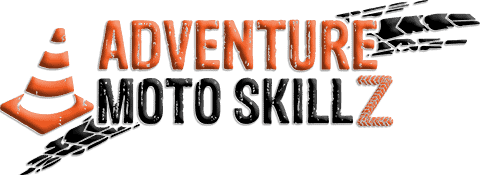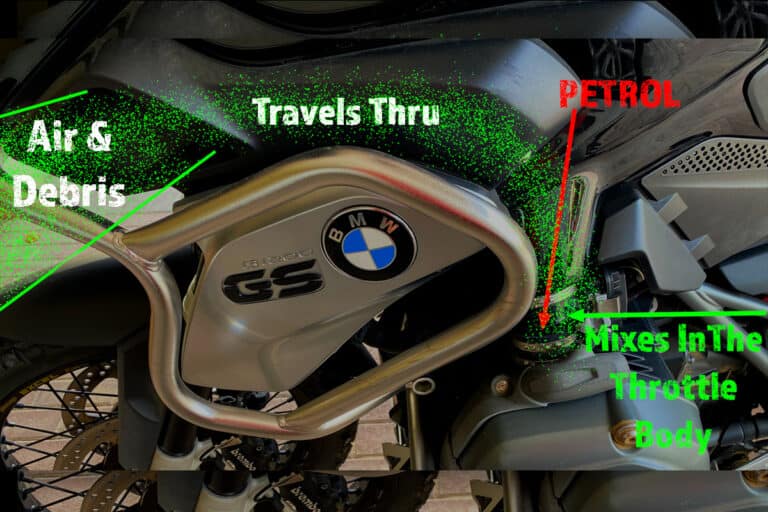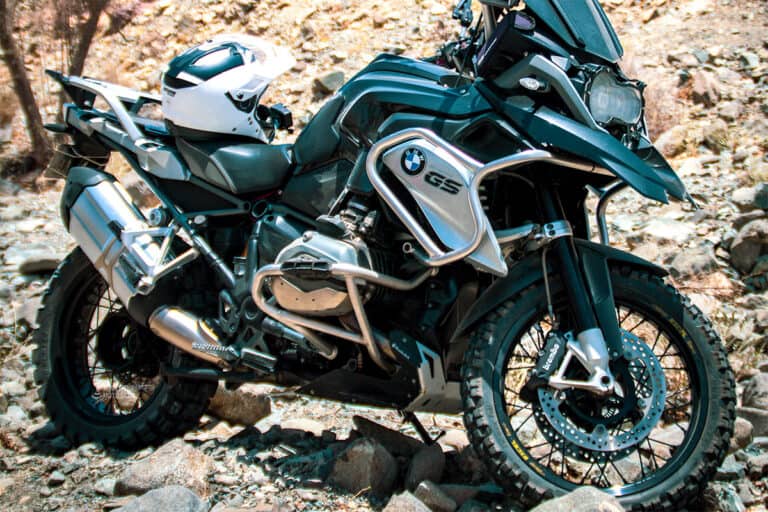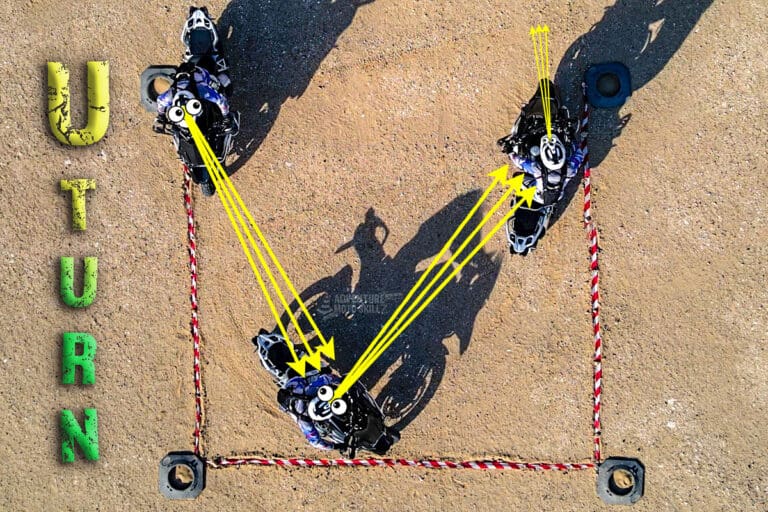Pro Tips on Becoming a Better ADV Off-Road Motorcycle Rider
There’s something about the thrill of off-road riding that just can’t be beaten. Whether you’re a beginner or seasoned motorcycle rider, there’s always something new to learn and experience. In this article, we will discuss some pro tips on becoming a better ADV off-road motorcycle rider; and our drill of choice for overall improvement just might surprise you.
To become a better off-road ADV motorcycle rider, prioritize drills that focus on balance and keeping traction. Balance drills develop counterbalance techniques that limit tips and falls; then we keep forward momentum by maintaining traction with precise throttle/friction zone control.
My early days of learning to ride off-road included frequent bike drops that inspired me to become a more capable and confident ADV motorcycle rider. I dedicated my training to learning techniques that would keep the bike upright and moving forward regardless of the changes in terrain. Now as a certified off-road instructor, I consistently rely on one simple exercise that offers up everything needed to reach my goals and my student’s goals. Let’s take a look.
This post may contain Affiliate Links. Please see our Privacy & Disclosure Policy for more details.
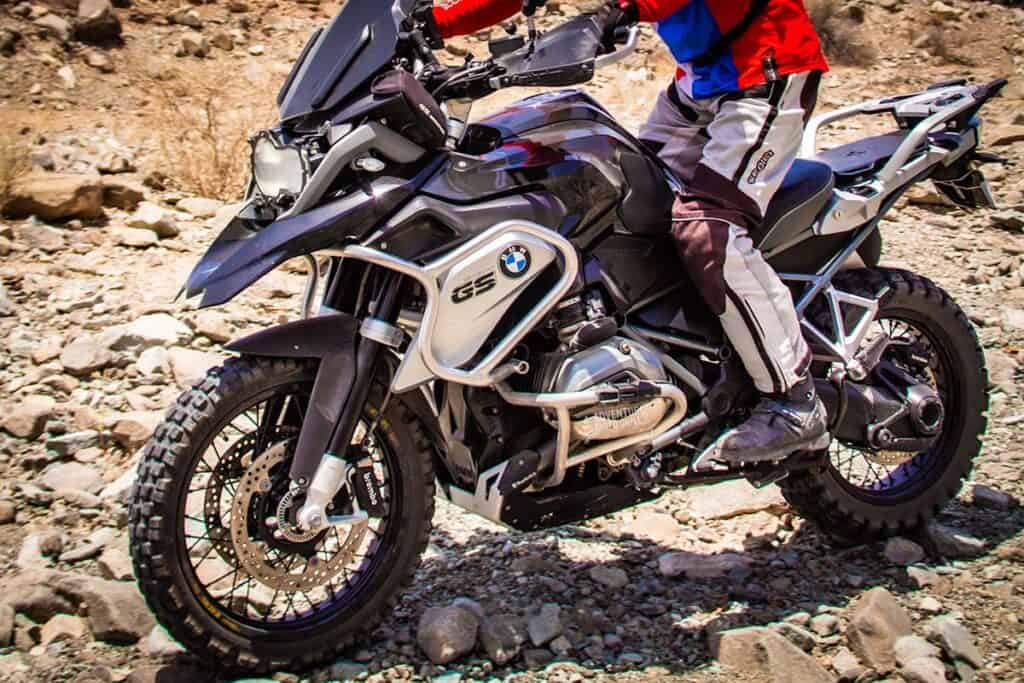
That’s right … we use cone drills to become better off-road ADV riders!
This is why cone drills help you become a better off-road motorcycle rider

Balance/Counterbalance skills
Imagine yourself riding some technical trails with small and medium-sized rocks covering your path. The bike is bouncing around underneath you as the dips and bumps of rock formations knock the front tire around and challenge your ability to keep the bike upright. Wouldn’t this be a great time to reach into your skills toolbox and reflexively know how to move and counterbalance?
Cones practice builds this needed muscle memory related to body position and counterbalancing techniques. With these reflexive movement skills etched into our riding DNA, we tackle off-road terrain with a much greater percentage of success and enjoyment.
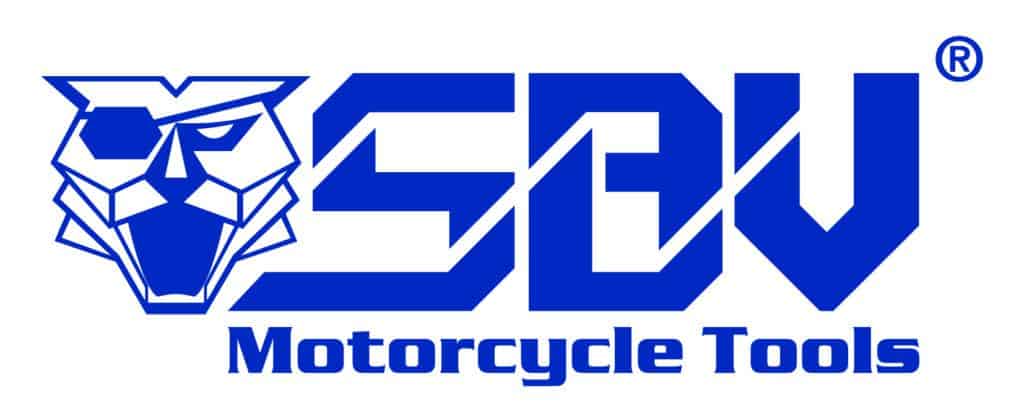
Innovative Motorcycle Tool Sets – Compact & Reliable
Used and recommended by ADVMotoSkillZ
ADV riding is a completely different feeling than driving on a well-manicured paved roadway and we need different skills to be comfortable riding it. Off-road terrain increases the difficulty of remaining balanced, due to the uneven and unpredictable surfaces. For that reason, we need balancing drills that train us to learn how to position ourselves on the bike.
These counterbalance techniques help us limit our drops and falls.
As we tackle off-road terrain, we want to be able to keep the bike upright in an instant with automatic riding habits; cone drills create these habits.
Maintain traction & Keep forward momentum
Imagine that rocky trail again… you are riding along the bumpy path and suddenly realize that you need to reduce your speed to stay in control, but you also want to keep moving forward. What are your instincts telling you to do at this moment to preserve your forward momentum while staying safe?
Cone drills will forge these precise throttle inputs that are needed for the wheels to maintain grip. Without this grip in corners and rough patches, we lose traction, lose momentum, and sometimes fall down. Cone drills teach us when to blip a burst of throttle to help stand up a falling bike while also developing top-notch clutch feathering skills.

Top-quality gear for your next adventure
Used and recommended by ADVMotoSkillZ
Feathering the clutch within the friction zone
A post about becoming a better ADV rider must include a tip about the friction zone. The clutch’s friction zone is that marvelous area of lever travel between the initial point of engagement and a fully released clutch. By “feathering”, or moving the clutch lever in and out within this zone, we dictate the amount of power being delivered to the rear wheel by the engine.
If you are an experienced rider with a solid understanding of clutch work and friction zone use, then challenge yourself with some of the more advanced cones drills offered below.
If feathering the clutch is a new skill for you or if you have never tried these foundational drills, then start here before moving ahead:
Walking the bike from the left side
- Stand on the left side of the bike
- Clutch lever fully pulled in
- Front Brake covered with 1 or 2 fingers
- Engine ON
- Bike in 1st gear
- Slowly open and close the clutch allowing the bike to slightly rock front to back
- Do not use any throttle
- Feel the friction point and friction zone movement
- When comfortable, slowly feather the clutch and allow it to roll forward at a walking pace only
- Pull the clutch in gently to slow the bike and release gently to move faster
- If the bike begins to move too quickly, pull the clutch in fully to cut power and/or engage the front brake
- Keep right hip in contact with the bike for support
Walking the bike from the right side
- same as above but from the right side
- use left hip to help support the bike
Walking large figure-8s & cone slalom from both sides of the bike
- this is more advance and can be used after feeling confident with the walking drill in a straight line
Drills for Skills – Improving off-road riding with cone drills
Cone drills are to adventure off-road riding, what free throws are to basketball. The greatest basketball players in history knew the key to success was to drill the basics at every practice. So don’t be fooled into thinking that cone drills are only for beginners, they are for us all. Cone drills will pay dividends in improved balance/counterbalance skills, friction zone improvement, and teaching how to keep momentum exactly when you need it.
Let’s look at the basic cone slalom and understand why this gem of an exercise is so important to our riding:
DO NOT perform cone slalom by simply turning the handle bars left to right to get around the cones.
DO perform the cone slalom by standing on the pegs and using your body weight to create lean angle and counterbalance the bike as you glide around each cone
Cone drills combine slow riding, body position, counterbalance, friction zone, throttle & braking all into one pass of the cones. This is one of the most accurate representations of real-world trail riding.
You don’t need a lot of cones to practice. Here are some fun and challenging drills that only use only 4 cones:
Not all cones are equal – which cones for which skill?
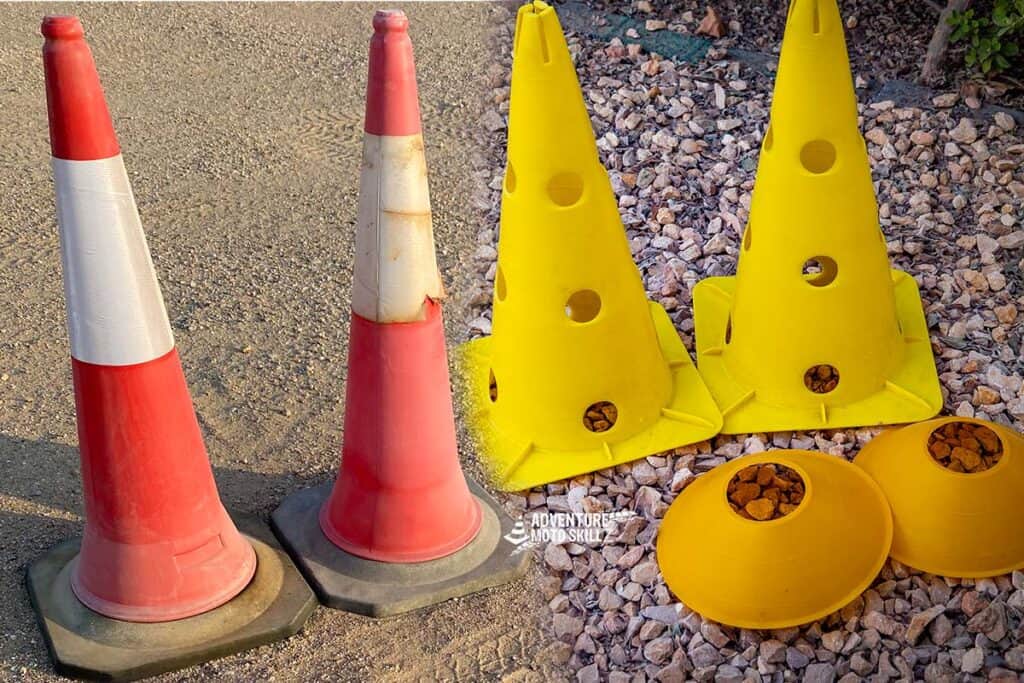
Ideal training includes cones of differing widths, heights, and weights for the most well-rounded learning experience. Stay within your budget and choose cones that match your training area and personal goals.
Flat cones
- lightweight
- easy to transport
- inexpensive to purchase
- very little chance of tipping over if you hit or ride over a flat cone
Short cones
- light – medium weight (not the best choice in windy conditions)
- need to get a bit more creative to transport these on your bike
- fairly inexpensive to purchase
- provide a larger physical barrier for your training
Tall cones
- heavier to move
- difficult to transport large cones on a bike
- the most expensive cone of our list
- the wide base means a wider turn radius is required to avoid running over the cone’s bottom
- the tall cone means handlebars can hit a cone if the bike is off-line
NO CONES? Don’t worry! If you do not have access to cones, then substitute with half-filled water bottles, flat rocks, or any other item that may be available in your training space. Stay safe with cone substitutes by choosing items that will not hurt you or your bike in case of a tip over.
Advanced cone drills to boost off-road skills development
The traditional cone slalom will continue to provide benefits to the most experienced rider, but these advanced cone drills will add a whole new layer to your skill set. The last tip on our list today is to continue to find new ways to challenge yourself with cones during drills training, so you can take on new challenges the next time you ride off-road.
Invite some riding partners over and have fun with these 3 advanced cone drills:
Off-set cone slalom
- Cones are 3 meters/yards apart
- Cones are offset left to right by the width of one cone
- The outside line is a bit slower and more challenging because it requires a larger turning radius and greater lean angle
- The inside line is more direct therefore faster to complete
- Each variation represents common riding scenarios when off-road
Flat cones criss-cross line
- Set out flat football cones approximately 4-5 meters/yards apart
- Allow the front tire to pass along one side of the cone
- Then guide the bike so the rear tire passes on the opposite side
Tennis Ball Slalom
- Set out tall cones with open tops (opening must be large enough for tennis ball to sit in)
- Cone can be 4-5 meters/yards apart either straight in line or offset for greater challenge
- Place a tennis ball on every other cone top
- Approach cones slowly and use right hand to move each tennis ball from one cone to the next
- Feather the clutch to control your speed
- Try to complete the line without any ball drops or foot dabs
Next-level advanced cone fun for off-road ADV motorcycling
If you are feeling confident with all of the drills reviewed above then it’s time to think out of the box. Place cones on inclines or declines to add challenge … or find unique terrain to test out your slalom skills:
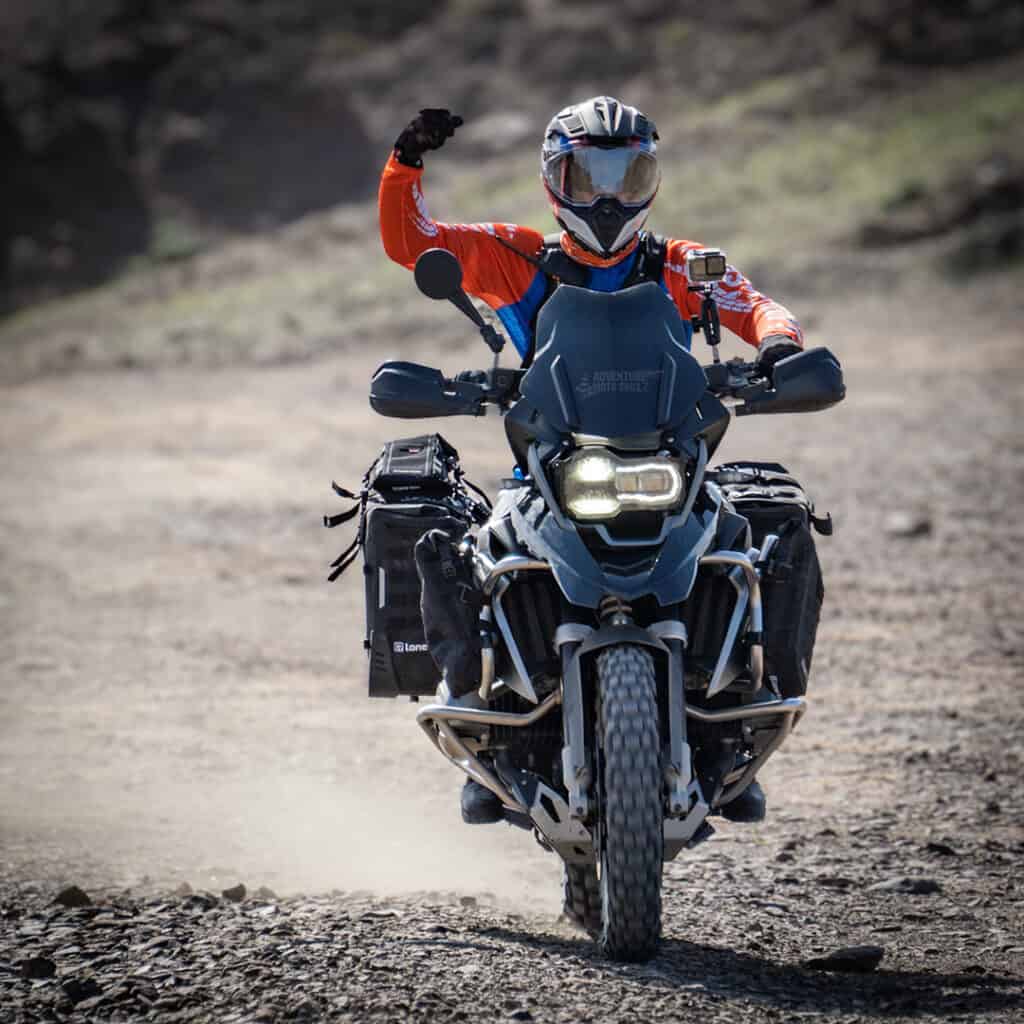
About the Author
Coach Mike is a Certified Off-Road Motorcycle Instructor & founder of ADVMotoSkillZ.
Riding tips from ADVMotoSkillZ reach thousands of international riders daily through social & blogs.
Click here to learn more about Mike’s motorcycle evolution from a Harley road rider to finding his true passion for off-road riding on a BMW 1200 GS.
If you would like to send Mike a quick message or invite him to provide training at your local facility, then visit the contact page here.
